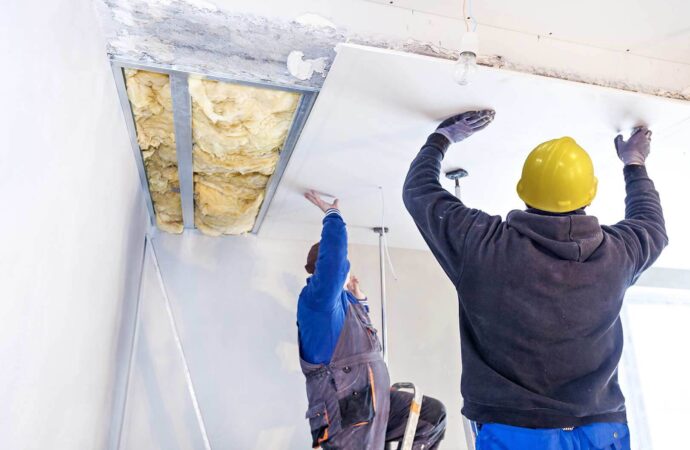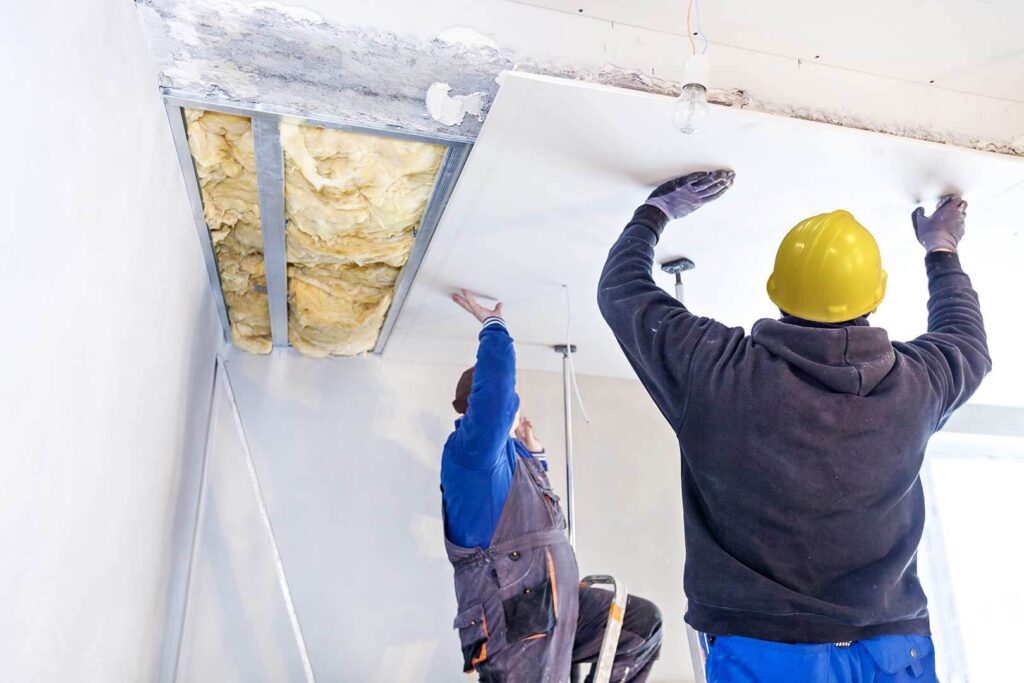Old habits die hard. This is true for building practices as well. Builders tend to stick to the same methods when finishing basements, especially if they can afford them. Why would they want to change what makes them money? They don’t have to be content with their job. A basement environment is very different from any other room in your home. This is why drywall is not recommended. It’s unlikely that drywall will work in a basement. And even if it does, it will not be the best material for the job. Here are four reasons you should remove drywall from your basement finish plan. The drywall can be a challenge when it comes to cabinets and shelves that weigh more than 10 pounds. This means you will need to locate wall studs to support the weight. It can be difficult and sometimes even dangerous. This will limit your options and leave you at the mercy, sometimes unevenly placed studs. It is common to mount shelves, cabinets, photos, or even a plasma TV on basement walls. It can also easily fall apart under too much weight. This is why it’s so popular for your children or you to make a hole in the wall. You can mount things on any wall using hardboard panels with dense foam insulation. These panels can create wall partitions, such as a bedroom or additional closet. The most challenging part of basement remodeling is dealing with drywall dust. Drywall installation can be a tedious task. The panels are made to fit into your basement. This will create thick, fine dust that covers everything. Dust can be invasive and cause damage to ordinary vacuum motors. It can clog their filters, overheat the motors and make them work harder. The average professional drywall vacuum costs about $650. This is prohibitive for homeowners and rarely used by professionals. The gypsum in drywall can irritate the eyes, lungs, sinuses, and throat. Drywall should permanently be installed with gloves, masks, and goggles. Drywall dust should be removed as soon as possible after installation. When renovating or servicing a basement, drywall ceilings can be a problem. When wiring or pipes need to be replaced, drywall ceilings can make it difficult to access them. Sometimes, the drywall might need to be damaged or removed. A service panel can make it easier to access the drop ceiling. Every ceiling tile doubles up as a service point. Even worse, heavy sheetrock ceiling installation can be labor-intensive and costly. If you decide to remodel your basement or first floor, you will spend hours running wires and pipes underneath the floor and learning about existing ones. There’s a reason drywall is filling up our landfills across the country. It is constantly being replaced and rebuilt due to water damage, plumbing leaks, moisture, mold, and impact damage. Even moisture-resistant drywall is not guaranteed against mold. Why? Why? Because drywall comprises layers of heavy-processed paper and a core of Gypsum. This paper is a food source for mold. Mold can grow on your drywall and make it less attractive. Mold symptoms include moldy walls, peeling or cracking paint, bulging behind the paint, musty odors, and discolored walls. The growth of toxic black mold can also be supported by drywall, which is especially dangerous. Even if poisonous molds are absent, the mold spores can cause asthma attacks and other health problems. Sometimes, it is necessary to remove the entire drywall and have it replaced by a professional. Total Basement Finishing offers products that are mold-resistant and are specifically designed for basement environments. The ceiling tiles and wall panels are ideal for basement finishing projects. The panels are easy to install without the hassle of drywall. They can also hold 300 pounds each without any problems. We offer free estimates and would wish to assist you. Drywall texture can be used to decorate walls and affordably. Drywall, also known as plasters board or gypsum board, is used for interior walls and ceilings. Because it involves heavy lifting, it is best to have more than one person involved in the drywall installation process. Drywall is a popular choice for partitioning. Drywall is a popular choice for partitioning due to its versatility, flexibility, and excellent performance. It takes practice and skill to install drywall. Drywall is available in large sheets measuring 4×12 inches. It is easy to install drywall. Taping the joints between panels is not difficult. This requires some practice. The next step after hanging the drywall has been completed is taping the drywall joints. Two types of tapes are used in this task. The self-adhesive fiberglass tapes and the plain paper black tape are both used. The fiberglass tape can be used directly over drywall. These are the leading equipment needed for taping: Before you begin preparing the surface for drywall, make sure to inspect the whole wall. You can tap any obstructions or nails with a hammer. You can now sand the wall to achieve a perfect drywall surface. Priming is the next step, done right before you paint. Primer the drywall will ensure that paint sticks well and lasts longer. To avoid paint dripping, start at the top and work your way down. Once you are done, you can begin painting. The final step is the drywall finish. Flat paint is easier to work with. You must allow 24 hours for drying between coats. Also, ensure that the wall is dry completely before applying the next coat. You will notice changes in the appearance of drywall after it dries. Although drywall sheets are usually made from paper, fiberglass is now being used. Fiberglass is more resistant to mold than paper drywall. Often, paper drywall can be exposed to water via floods or leakage. This causes the growth of mold. Mold can cause problems with the area’s hygiene and affect the room’s overall aesthetics. You have two options for finishing your ceilings and walls with drywall. Drywall installation is much easier than other interior finishing materials. You can save money by doing it yourself. You can save money for other home improvements that you may be interested in. The mudding and taping are the final steps after hanging the drywall. While some find this difficult, others find it much easier than hanging the drywall. You can finish your ceilings and walls the way you want them to look if you are familiar with the basics and have the tools to tap the drywall. A perfectly finished drywall installation will be smooth and spotless if you use proper mudding and taping. Tape, drywall tape, drywall knife in 6″, 8″, 10, or 12″ sizes, sandpaper or drywall sander, and ready-mixed joint compound are all necessary for taping drywall joints. Start using your 6-inch corner knife to spread a thin layer of mud at the joints where the drywall sheets meet. Tape the mud onto the joints and use the corner knife to press the tape. For a smoother finish, smoothen the edges by moving the corner knife downwards. Allow it to dry overnight. After the mud has dried completely, you can remove any bumps using your 8-inch knife or sandpaper. Next, apply the next layer of mud to the tape. This time it will be 6-8 inches wider. Allow it to dry for another night. Use your giant knife to apply the second coat. Let dry the 12″-wide thin coat overnight. Sanding is the final step to finishing the taped drywall. The sandpaper will make sanding much easier, especially if you have a large area to sand. Drywall sanders can be equipped with vacuum attachments for faster, more efficient, and less messy sanding. This type of drywall is most commonly used (white paper front) for home improvements and new interior construction. Check with your building codes before starting a project to ensure they don’t specify which type of drywall is required. Standard drywall comes in two sizes: 4×8′ and 4×12′. The size of the area in which you want to install drywall will determine the size of your workspace, how many people are involved, and the access requirements of your workers (in a basement, for example, it might be challenging to turn a corner using a 12′ sheet). It isn’t easy to use 4×12 sheets with one person. I recommend using 4×12 sheets whenever possible. This reduces the number of cuts required to finish the joints. You can also buy standard drywall in different widths: 1/4″, 3/8″, 1/2″, and 5/8″. The standard width for interior construction is 1/2″. Most local building codes consider 1/2″ drywall acceptable. 1/4 inch drywall is also known as Flex-board. It’s often used to create curves. It can be fragile, so it is not recommended for inexperienced drywall installers. 5/8″ drywall can be used in high-traffic areas, commercial settings, and where noise control or insulation is required. Local codes may require 5/8″ drywall in certain regions. Green Board is another name for moisture-resistant drywall. This refers to the water-resistant green papers that are used outside of gypsum. Commonly, moisture-resistant drywall is used in high-moisture areas like bathrooms and kitchens. The only difference is that the paper backing used in this drywall has a higher moisture resistance than regular drywall. Green board is best used in bathrooms and damp basements. It can also be used in kitchens, especially around stoves or sinks. The Green board is neither waterproof nor fire-resistant. However, it is resistant to damp conditions. We offer the above services at the following locations within Boca Raton:
If you are located in Palm Beach County and you don’t see your city/area listed above, don’t worry! We cover all of Palm Beach County. Fill out the contact form above or CLICK HERE and send us a message. We’ll get back to you asap!
Drywall Installation
Contact Us

Holding its Own
Drywall dust
Renovation and Service
Black Mold Blues

Better Solutions
Partitioning
Taping Drywall
Tape Materials
Fiberglass is used to stop mold growth.
Standard Drywall
Green Board is Moisture-Resistant Drywall
Locations We Serve

